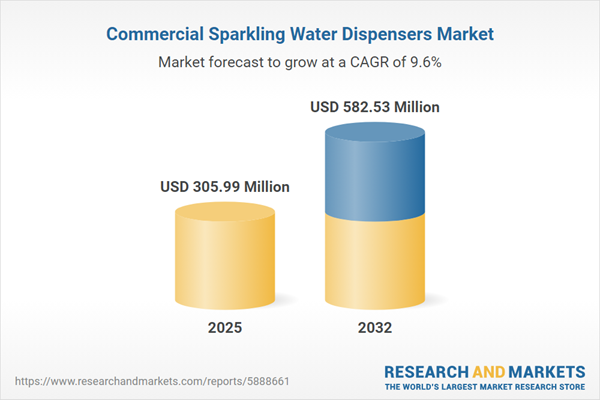Speak directly to the analyst to clarify any post sales queries you may have.
Commercial sparkling water dispensers have become a strategic asset for organizations focused on modern employee needs, resource management, and long-term sustainability objectives. Senior decision-makers are prioritizing solutions that enhance productivity, align with evolving compliance mandates, and support scalable operations across varied business environments.
Market Snapshot: Commercial Sparkling Water Dispensers
The commercial sparkling water dispensers market reached USD 279.03 million in 2024, with growth forecasted to USD 305.99 million by 2025 and USD 582.53 million by 2032, representing a 9.63% CAGR. Key market drivers include the ongoing shift toward corporate sustainability initiatives, updated workplace wellness programs, and increased attention to responsible resource use. Organizations view these dispensers as tools for supporting compliance, maintaining reliability, and adapting to changing operational needs. With efficiency and sustainability central to beverage services, commercial sparkling water dispensers are finding rapid adoption in corporate, hospitality, and institutional settings.
Scope & Segmentation for Senior Decision-Makers
Comprehensive segmentation helps organizations select commercial sparkling water dispensers that best address current and future operational needs. Attention to detailed segmentation ensures investment decisions contribute to process optimization, cost control, and brand enhancement.
- End User: Large enterprises seek high-capacity units for steady, high-volume dispensing, while small and mid-sized businesses typically opt for compact models to balance throughput with space efficiency. Residential users prioritize intuitive operation.
- Product Type: Countertop dispensers solve space limitations, freestanding kiosks are suitable for high-traffic environments, and undercounter models integrate seamlessly into existing layouts for a streamlined experience.
- Distribution Channel: Procurement occurs via food service partnerships, retail establishments, digital commerce platforms, and supermarket or hypermarket networks, diversifying sourcing strategies to accommodate sector-specific supply needs.
- Operation Mode: Options span fully automatic, semi-automatic, or manual mechanisms, enabling organizations to select workflow-compatible, hygiene-conscious solutions.
- Installation Type: Wall-mounted or built-in units deliver fixed installation flexibility, while portable tabletop solutions allow for reconfigurable or temporary setups as operational demands evolve.
- Pricing Tier: Selections range from cost-efficient entry-level models to premium offerings, allowing organizations to align investment with performance and lifecycle requirements.
- Geographic Coverage: Adoption patterns and product offerings vary by Americas, Europe, Middle East & Africa, and Asia-Pacific, as each region adapts to regulatory conditions and local market preferences.
- Leading Companies: Organizations such as Primo Water Corporation, SodaStream International Ltd, The Manitowoc Company, Culligan International, Waterlogic Limited, Zip Industries, Richard Alan, Quench USA, and Aarke AB contribute to innovation and competition.
- Enabling Technologies: Advances include sophisticated carbonation, advanced filtration, IoT remote monitoring, modular construction supporting scalable application, and compressors designed for energy efficiency and resource conservation.
Key Takeaways for Commercial Sparkling Water Dispensers Adoption
- Implementing dispensers helps organizations achieve broader sustainability goals and readiness for evolving compliance standards across business sectors.
- Customizing beverage options, such as adjustable carbonation and flavors, can improve employee satisfaction and reinforce workplace wellness initiatives without increasing operational complexity.
- IoT-enabled solutions provide performance monitoring, enable centralized maintenance scheduling, and support consistency, particularly in organizations with distributed sites or facilities.
- Flexible unit formats and modular system designs provide scalable beverage service, simplifying adaptation during organizational growth, workforce changes, or facility expansion.
- Strategic engagement with experienced suppliers and channel partners ensures dependable supply, diverse deployments, and market reach across hospitality, retail, and commercial venues.
- Regular servicing of dispensers supports long-term reliability, reducing downtime and helping maintain consistently high beverage quality at every location.
Tariff Impact on the Commercial Sparkling Water Dispensers Market
Recent tariff adjustments in the U.S. have introduced new complexity for procurement teams. To address challenges relating to supply reliability, many businesses are relocating production closer to target markets, fortifying strategic partnerships, and standardizing product components. These steps help reduce risk and enhance supply assurance within the sparkling water dispenser segment.
Methodology & Data Sources
This analysis draws on secondary research, industry leader interviews, patent review, and regulatory assessment, complemented by selected case studies. The approach delivers validated, benchmarked data for strategic organizational planning.
Why This Report Matters
- Senior leaders receive actionable insights into operational and regulatory factors influencing the commercial sparkling water dispensers market.
- Procurement and distribution teams gain frameworks for optimizing sourcing, risk management, and long-term planning within this evolving segment.
- The report supports organizations seeking to drive sustainable growth and maintain sector competitiveness while aligning with emerging operational priorities.
Conclusion
Adopting commercial sparkling water dispensers enables organizations to enhance beverage management and advance sustainability goals, positioning them to respond proactively to changing workforce expectations and operational demands.
Additional Product Information:
- Purchase of this report includes 1 year online access with quarterly updates.
- This report can be updated on request. Please contact our Customer Experience team using the Ask a Question widget on our website.
Table of Contents
3. Executive Summary
4. Market Overview
7. Cumulative Impact of Artificial Intelligence 2025
Companies Mentioned
The companies profiled in this Commercial Sparkling Water Dispensers market report include:- Primo Water Corporation
- SodaStream International Ltd
- The Manitowoc Company, Inc.
- John Bean Technologies Corporation
- Culligan International Company LLC
- Waterlogic Limited
- Zip Industries (Aust.) Pty Ltd
- Richard Alan Pty Ltd
- Quench USA, Inc.
- Aarke AB
Table Information
| Report Attribute | Details |
|---|---|
| No. of Pages | 198 |
| Published | October 2025 |
| Forecast Period | 2025 - 2032 |
| Estimated Market Value ( USD | $ 305.99 Million |
| Forecasted Market Value ( USD | $ 582.53 Million |
| Compound Annual Growth Rate | 9.6% |
| Regions Covered | Global |
| No. of Companies Mentioned | 11 |









